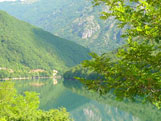Macedonia
The SpecialEasts on the road for you:
Western europe. Eastern europe. Balkans. Turkey. CIS. Middle East. Central Asia.

Zenit offers the following services for Macedonia:
You need to transport goods from or to Macedonia? Just give us a call.
Our team will find the right solution for you!
Macedonia - brief overview about the Zenit destination Macedonia.
Geopraphy

Macedonia is has a total area of 25,333 km2 (9,781 sq mi). It has some 748 km (465 mi) of boundaries, shared with Serbia (62 km or 39 mi) to the North, Kosovo (159 km or 99 mi) to the northwest, Bulgaria (148 km or 92 mi) to the east, Greece (228 km or 142 mi) to the south, and Albania (151 km or 94 mi) to the west. It is a transit way for shipment of goods from Greece, through the Balkans, towards Eastern, Western and Central Europe and through Bulgaria to the East. It is part of a larger region also known as Macedonia, which also includes a region of northern Greece known by the same name; and the Blagoevgrad province in southwestern Bulgaria.
Demographics

Macedonia has an estimated population of 2,061,315 citizens. The largest ethnic group in the country are the Slavic-speaking ethnic Macedonians. The second largest group are the Albanians who dominated much of the western part of the country. Some unofficial estimates indicate that in the Republic of Macedonia there are possibly up to 260,000 Roma. The largest Macedonian cities according to the 1994 census data (as the 2002 census data does not list both city populations and municipality populations).
Economy
Recently ranked as the fourth 'best reformatory state' out of 178 countries ranked by the World Bank, Macedonia has undergone considerable economic reform since independence. The country has developed an open economy with trade accounting for more than 90% of GDP in recent years. Since 1996, Macedonia has witnessed steady, though slow, economic growth with GDP growing by 3.1% in 2005. This figure was projected to rise to an average of 5.2% in the 2006-2010 period. The government has proven successful in its efforts to combat inflation, with an inflation rate of only 3% in 2006 and 2% in 2007[49] and has implemented policies focused on attracting foreign investment and promoting the development of Small and Medium-sized Enterprises (SMEs). The current government introduced a flat tax system with the intention of making the country more attractive to foreign investment. The flat tax rate was 12% in 2007 and was further lowered to 10% in 2008.
Despite these reforms, as of 2005 Macedonia's unemployment rate was 37.2% and as of 2006 its poverty rate was 22%. Corruption and a relatively ineffective legal system also act as significant restraints on successful economic development. Macedonia still has one of the lowest per capita GDPs in Europe. Furthermore, the country's grey market is estimated at close to 20% of GDP.
In terms of structure, as of 2005 the service sector constituted by far the largest part of GDP at 57.1%, up from 54.2% in 2000. The industrial sector represents 29.3% of GDP, down from 33.7% in 2000 while agriculture represents only 12.9%, up from 12%. Textiles represent the most significant sector for trade, accounting for more than half of total exports. Other important exports include iron, steel, wine and vegetables.
With a GDP per capita of $9,157 at purchasing power parity and a Human Development Index of 0.808, Macedonia is less developed and has a considerably smaller economy than most of the former Yugoslav states. According to Eurostat data, Macedonian PPS GDP per capita stood at 32 per cent of the EU average in 2008.
Climate
Macedonia has a transitional climate from Mediterranean to continental. The summers are hot and dry and the winters are moderately cold. Average annual precipitation varies from 1,700 mm (66.9 in) in the western mountainous area to 500 mm (19.7 in) in the eastern area. There are three main climatic zones in the country: temperate Mediterranean, mountainous and mildly Continental. Along the valleys of the Vardar and Strumica rivers, in the regions of Gevgelija, Valandovo, Dojran, Strumica and Radoviš the climate is temperate Mediterranean. The warmest regions are Demir Kapija and Gevgelija, where the temperature in July and August frequently exceeds 40 °C (104 °F). The mountainous climate is present in the mountainous regions of the country and it is characterised by long and snowy winters and short and cold summers. The spring is colder than the fall. The majority of Macedonia has a moderate continental climate with warm and dry summers and relatively cold and wet winters. There are 30 main and regular weather stations in the country.
Infrastructure

Macedonia, together with Montenegro, Bosnia and Herzegovina and Kosovo, belonged to the less developed southern region of the former Yugoslavia. It suffered severe economic difficulties after independence, when the Yugoslav internal market collapsed and subsidies from Belgrade ended. In addition, it faced many of the same problems faced by other former socialist East European countries during the transition to a market economy. Its main land and rail exports route, through Serbia, remains unreliable with high transit costs, thereby affecting the export of its formerly highly profitable, early vegetables market to Germany. Macedonia's IT market increased 63.8% year on year in 2007, which is the Fastest Growing in the Adriatic Region.
More Information: http://en.wikipedia.org/wiki/Macedonia
Text is available under the Creative Commons Attribution-ShareAlike License; additional terms may apply. See Terms of Use for details.
Wikipedia® is a registered trademark of the Wikimedia Foundation, Inc., a non-profit organization.

 Deutsch
Deutsch Turkce
Turkce Russian
Russian